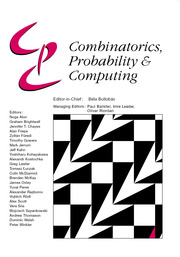Crossref Citations
This article has been cited by the following publications. This list is generated based on data provided by Crossref.
Cooper, Colin
1995.
On the 2‐cyclic property in 2‐regular digraphs.
Random Structures & Algorithms,
Vol. 6,
Issue. 4,
p.
439.
Janson, Svante
1995.
Random Regular Graphs: Asymptotic Distributions and Contiguity.
Combinatorics, Probability and Computing,
Vol. 4,
Issue. 4,
p.
369.
Molloy, M. S. O.
Robalewska, H.
Robinson, R. W.
and
Wormald, N. C.
1997.
1‐Factorizations of random regular graphs.
Random Structures & Algorithms,
Vol. 10,
Issue. 3,
p.
305.
2000.
Random Graphs.
p.
307.
Cooper, Colin
2001.
The union of two random permutations does not have a directed Hamilton cycle.
Random Structures and Algorithms,
Vol. 18,
Issue. 1,
p.
95.
Frieze, Alan
2001.
Hamilton cycles in the union of random permutations.
Random Structures and Algorithms,
Vol. 18,
Issue. 1,
p.
83.
Chebolu, Prasad
and
Frieze, Alan
2008.
Hamilton Cycles in Random Lifts of Directed Graphs.
SIAM Journal on Discrete Mathematics,
Vol. 22,
Issue. 2,
p.
520.
Greenhill, Catherine
and
McKay, Brendan D.
2009.
Random dense bipartite graphs and directed graphs with specified degrees.
Random Structures & Algorithms,
Vol. 35,
Issue. 2,
p.
222.
Zhang, Jinshan
and
Bai, Fengshan
2011.
An improved fully polynomial randomized approximation scheme (FPRAS) for counting the number of Hamiltonian cycles in dense digraphs.
Theoretical Computer Science,
Vol. 412,
Issue. 4-5,
p.
419.
Battaglia, Giovanni
Grossi, Roberto
and
Scutellà, Noemi
2012.
Consecutive ones property and PQ-trees for multisets: Hardness of counting their orderings.
Information and Computation,
Vol. 219,
Issue. ,
p.
58.
He, Wei Hua
Li, Hao
Bai, Yan Dong
and
Sun, Qiang
2017.
Linear arboricity of regular digraphs.
Acta Mathematica Sinica, English Series,
Vol. 33,
Issue. 4,
p.
501.
Li, Hui
Zhang, Bo
Peng, Jin
and
Ge, Xiangyu
2020.
Local Connectivity of Uncertain Random Graphs.
IEEE Access,
Vol. 8,
Issue. ,
p.
115548.
Ren, Zelin
and
Hou, Xinmin
2022.
Pancyclicity of randomly perturbed digraph.
JUSTC,
Vol. 52,
Issue. 5,
p.
2.
Dovgal, Sergey
de Panafieu, Élie
Ralaivaosaona, Dimbinaina
Rasendrahasina, Vonjy
and
Wagner, Stephan
2024.
The birth of the strong components.
Random Structures & Algorithms,
Vol. 64,
Issue. 2,
p.
170.

